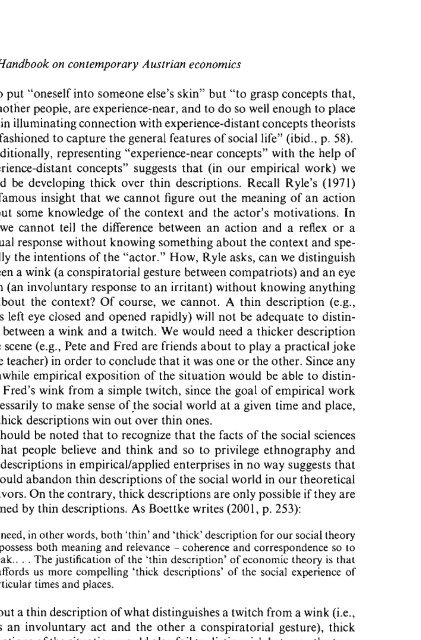Handbook on Contemporary Austrian Economics
Handbook on Contemporary Austrian Economics
Handbook on Contemporary Austrian Economics
You also want an ePaper? Increase the reach of your titles
YUMPU automatically turns print PDFs into web optimized ePapers that Google loves.
38 <str<strong>on</strong>g>Handbook</str<strong>on</strong>g> <strong>on</strong> c<strong>on</strong>temporary <strong>Austrian</strong> ec<strong>on</strong>omics<br />
not to put "<strong>on</strong>eself into some<strong>on</strong>e else's skin" but "to grasp c<strong>on</strong>cepts that,<br />
for another people, are experience-near, and to do so well enough to place<br />
them in illuminating c<strong>on</strong>necti<strong>on</strong> with experience-distant c<strong>on</strong>cepts theorists<br />
have fashi<strong>on</strong>ed to capture the general features of social life" (ibid., p. 58).<br />
Additi<strong>on</strong>ally, representing "experience-near c<strong>on</strong>cepts" with the help of<br />
"experience-distant c<strong>on</strong>cepts" suggests that (in our empirical work) we<br />
should be developing thick over thin descripti<strong>on</strong>s. Recall Ryle's (1971)<br />
now famous insight that we cannot figure out the meaning of an acti<strong>on</strong><br />
without some knowledge of the c<strong>on</strong>text and the actor's motivati<strong>on</strong>s. In<br />
fact, we cannot tell the difference between an acti<strong>on</strong> and a reflex or a<br />
habitual resp<strong>on</strong>se without knowing something about the c<strong>on</strong>text and specifically<br />
the intenti<strong>on</strong>s of the "actor." How, Ryle asks, can we distinguish<br />
between a wink (a c<strong>on</strong>spiratorial gesture between compatriots) and an eye<br />
twitch (an involuntary resp<strong>on</strong>se to an irritant) without knowing anything<br />
else about the c<strong>on</strong>text Of course, we cannot. A thin descripti<strong>on</strong> (e.g.,<br />
Fred's left eye closed and opened rapidly) will not be adequate to distinguish<br />
between a wink and a twitch. We would need a thicker descripti<strong>on</strong><br />
of the scene (e.g., Pete and Fred are friends about to playa practical joke<br />
<strong>on</strong> the teacher) in order to c<strong>on</strong>clude that it was <strong>on</strong>e or the other. Since any<br />
worthwhile empirical expositi<strong>on</strong> of the situati<strong>on</strong> would be able to distinguish<br />
Fred's wink from a simple twitch, since the goal of empirical work<br />
is necessarily to make sense of .the social world at a given time and place,<br />
then thick descripti<strong>on</strong>s win out over thin <strong>on</strong>es.<br />
It should be noted that to recognize that the facts of the social sciences<br />
are what people believe and think and so to privilege ethnography and<br />
thick descripti<strong>on</strong>s in empiricaVapplied enterprises in no way suggests that<br />
we should aband<strong>on</strong> thin descripti<strong>on</strong>s of the social world in our theoretical<br />
endeavors. On the c<strong>on</strong>trary, thick descripti<strong>on</strong>s are <strong>on</strong>ly possible if they are<br />
informed by thin descripti<strong>on</strong>s. As Boettke writes (2001, p. 253):<br />
we need, in other words, both 'thin' and 'thick' descripti<strong>on</strong> for our social theory<br />
to possess both meaning and relevance - coherence and corresp<strong>on</strong>dence so to<br />
speak ... . The justificati<strong>on</strong> of the 'thin descripti<strong>on</strong>' of ec<strong>on</strong>omic theory is that<br />
it affords us more compelling 'thick descripti<strong>on</strong>s' of the social experience of<br />
particular times and places.<br />
Without a thin descripti<strong>on</strong> of what distinguishes a twitch from a wink (i.e.,<br />
<strong>on</strong>e is an involuntary act and the other a c<strong>on</strong>spiratorial gesture), thick<br />
descripti<strong>on</strong>s of the situati<strong>on</strong> would also fail to distinguish between the two.<br />
Stated another way, without theory/models that explain a phenomen<strong>on</strong><br />
while abstracting away much of the social detail, without "experiencedistant<br />
c<strong>on</strong>cepts" to use Geertz's formulati<strong>on</strong>, the applied social scientist<br />
could not make sense of social life, he could not offer thick descripti<strong>on</strong>s.

















